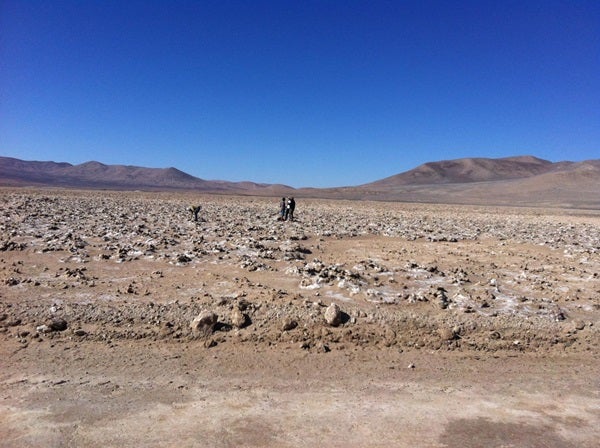Sitting on the western edge of South America, it isn’t uncommon for decades to pass without rainfall in the Atacama Desert. But somehow, microorganisms manage to survive in the extremely dry conditions. So if life can survive in this harsh environment, could it be also surviving on Mars’ arid surface?
Atacama’s hyperarid environment is the closest thing we have on Earth to Mars’ surface, and microbial life is continually found in its desert soil. But researchers have long wondered whether these microbes have been there all along, somehow sustaining themselves without water, or if they’re simply carried in with the weather and left to dry.
An international group of researchers, led by planetary scientist Dirk Schulze-Makuch of Washington State University, recently conducted a study of the desert’s microorganisms, and found that they’re able to lie dormant for prolonged periods of time and reactivate when hit with water. This discovery leaves researchers wondering if microbes on Mars could use similar periods of dormancy and reactivation when snowfall or other moisture occurs.
“It has always fascinated me to go to the places where people don’t think anything could possibly survive and discover that life has somehow found a way to make it work,” said Schulze-Makuch in a press release. “Jurassic Park references aside, our research tell us that if life can persist in Earth’s driest environment there is a good chance it could be hanging in there on Mars in a similar fashion.”
When the research team made their first trip to Atacama in 2015, they were met with something unexpected — rain. Although they hadn’t anticipated the extraordinarily rare rainfall, it gave them a unique opportunity to see how the organisms react to a resurgence of water. After the rainfall, they carefully gathered soil samples and performed genomic testing on the microbes to see which groups reproduced under these conditions. They found that multiple indigenous species, which had adjusted to the arid conditions and learned to survive without water by falling dormant, were now reproducing.
As the moisture continued to dissipate in 2016 and 2017, the team went back to see how the indigenous communities were holding up, and found that they were slowly returning to their dormant state.
“In the past researchers have found dying organisms near the surface and remnants of DNA but this is really the first time that anyone has been able to identify a persistent form of life living in the soil of the Atacama Desert,” said Schulze-Makuch. “We believe these microbial communities can lay dormant for hundreds or even thousands of years in conditions very similar to what you would find on a planet like Mars and then come back to life when it rains.”
Despite both Atacama and Mars being incredibly dry, there are vast differences that need to be considered when pondering dormant life on the Martian surface, like significantly colder temperatures and a much drier environment. However, the bodies of water that existed billions of years ago on Mars give researchers hope that the organisms existing within them managed to go dormant, and are patiently waiting for a resurgence of moisture.
But until we find a way to test Mars’ soil for signs of dormant microbial life, there’s really no way of knowing whether or not it exists. So in the meantime, we might as well continue testing our methods on the closest environment we’ve got, right?










